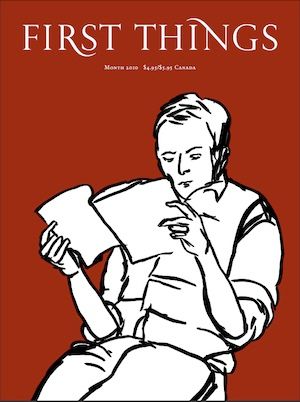I shall explain that first by pointing readers to a favorable post by The Anchoress, another FT blogmeister, and quoting what she quotes from Bottum's post announcing the change:
…we have now undertaken the redesign that begins with this issue. In the public discussions of America, First Things works for several things. The fight, for example, with those who want to strip the world of its religious clothing and create the naked public square. The long struggle against the murderousness of abortion. The attempt to sort out the good of modern democracy and science from the horrors that have emerged through what we insist are wrong turns taken in the name of modernity. And, most of all, the effort to be physicians to this Iron Age in which we live—the effort to reinvest the world with the richness, thickness, and freshness that is found only in truly God-haunted nations and societies.Much as my conservative instincts once resisted such thinking, I must agree. A serious magazine of ideas must give people a reason to buy it and carry it around with them at at time when they can get more interactive, if more ephemeral, content online. If you're like me, you often find yourself in situations where you're forced to wait for something, or just need a little quiet time, or, heaven forfend, can't get online. I usually carry a book around with me to deal with such situations. But my default print companion shall now be a sexier First Things.
But, as a magazine, First Things also works to preserve the high culture of intellectual journals: a culture that is fading under pressure from the Internet, from the weak American financial situation, and, not to mince words, from the absurd decline of print standards in this country.
Many magazines have given up on poetry—and so we print poems. Many magazines have given up on the long-form reporting that was once the glory of American journalism—and so we want to showcase that kind of story. Many magazines have given up on intellectual essays—and so we continue to present them, as we have always done, to our readers. For that matter, many magazines have given up on superior and intellectually challenging crossword puzzles—and so (over some internal objections, I should note) I demanded that we pick up, as well, that fallen standard of journalism.
Most of all, American magazines these days seem to have given up on elegance—and so we decided to demand art covers, and interior photographs, and fine text layout.
In other words, First Things defiantly refuses to accept the diminished condition of American print today. The object in your hands must be a pleasure to hold and read—or what good is a printed journal, with the cacophony of the Web sounding all around us?
I hope that the rest of the FT readership agrees. If the magazine can retain and expand its true substance while appealing to a broader demographic, then that substance will be more widely disseminated. That is certainly needed more than ever. Bottum's move is admittedly a gamble; but in today's aversive environment for print periodicals, I don't see that he had much choice.






























